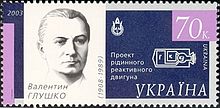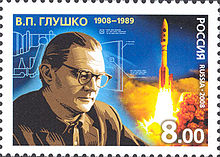Valentin Petrovich Glushko
Valentin Glushko ( Russian Валентин Петрович Глушко ., Scientific transliteration Valentin Petrovich Głusko ; Ukrainian Валентин Петрович Глушко Walentyn Petrowytsch Hluschko * August 20 jul. / 2 September 1908 greg. In Odessa , Russian Empire ; † 10. January 1989 in Moscow ) was a Soviet engineer of Ukrainian descent and known as the chief designer of rocket motors .
Life
The son of a nurse began studying aeronautics at the age of 13 after reading novels by Jules Verne . He studied at a business school in Odessa. During this time, Gluschko conducted experiments with explosives . He got to these by unexploded artillery shells, which the white army had left behind when they withdrew during the civil war . Since 1924/25 he wrote articles about the exploration of the moon and about the use of Ziolkowski's engines for space flight .
Glushko studied physics and mathematics in Leningrad , but left the university in April 1929 without a degree. From 1929 to 1930 he conducted rocket research at the gas dynamics laboratory . He also became a member of the GIRD , which was founded in Leningrad in 1931.
He was arrested on March 23, 1938 as part of the Great Terror in the Soviet Union . On August 15, 1939, he was sentenced to eight years in the gulag . In 1938 while he was in “ pre- trial detention”, under the influence of violence, he also denounced his colleague Sergei Pavlovich Koroljow to the NKVD , who was sentenced to ten years in the Gulag.
Because of his qualifications, Glushko was allowed to work with other imprisoned scientists in a special camp of the NKVD (Sharashka) on various aircraft designs, first in Tushino and then as head of OKB-16 in an aircraft factory in Kazan , where the imprisoned Korolev also worked from October 1942. The prison conditions there were much milder than in normal Soviet labor camps. The multi-purpose aircraft Petlyakov Pe-2 was successfully tested for the first time as a prototype Pe-2RD on October 1, 1943, with a switchable RD-1 rocket drive to improve take-off behavior and climb performance. On August 10, 1944, Glushko and Korolev were released on parole due to a special decree.
At the end of the Second World War , Gluschko was sent to Germany to study the German missile program (see: Unit 4 ). In 1946 he became the chief designer of his own department, the OKB 456, and remained in this position until 1974. This department was to play an important role in the development of rocket motors in the Soviet Union.
His OKB 456 developed the RD-101 (340 kN thrust) engine for the R-2 rocket, the RD-110 (1180 kN) for the R-3 and the RD-103 (430 kN) for the R-5 . The famous and still used R-7 uses four RD-107s and one RD-108 from Gluschkos OKB as a drive . In 1954 he began to design drives for the R-12 developed by Michail Kusmitsch Jangel . He created the world's most powerful fluid jet ever flown in the 1980s with the RD-170 for Energija (7903 kN).
After the successful moon landings in the USA , Brezhnev decided in 1974 to end the problematic Soviet moon landing program. He relieved Vasily Pavlovich Mishin of his post and instead gave Gluschko responsibility for the ZKBEM , the former OKB-1 Korolev, which was later renamed NPO Energia. As a first act, Gluschko canceled the N1 rocket, a program that had long been criticized. Previously, the final break between Korolev and Gluschko had already come about through the design of the N1 moon rocket. Both had hopelessly and a. There was a dispute over the engine design (one-chamber versus four-chamber engine) and the fuel combination to be used ( kerosene / oxygen versus UDMH / nitrous tetroxide ).
Glushko was a representative of a new series of powerful launch vehicles that he wanted to use to establish a Soviet lunar base. However, after the US Apollo program came to an end and the US introduced the space shuttle , the Soviet government wanted to build a counterpart to the shuttle. In the following years Gluschko became the most influential advocate of the Buran program , on which up to 30,000 people worked at times. It was only after his death in 1989 that Glushko's efforts became known to the broader Soviet public. After budget problems and the end of the Cold War , the Buran program was officially discontinued in 1993.
While Gluschko attached great importance to a well-groomed appearance and never lacked self-esteem, his character was often perceived as stubborn. One of his most significant and long-term wrong decisions was to reject hydrogen as a rocket fuel . As a result, the Soviet rocket experts were still discussing the use of hydrogen as fuel, while NASA employees were already assembling the Saturn V. Gluschko's design office also failed to design an engine with a large combustion chamber in order to remain competitive with the American F-1 engine used in the Saturn V. These decisions and mistakes contributed to the failure of the N1, for which Korolev's successor Vasily Pavlovich Mishin now had to rely on a large number of smaller engines. Even later, Gluschko never mastered the instabilities of large combustion chambers : his pragmatic solution was the use of several bundled smaller combustion chambers, which are supplied with fuel by a common powerful turbo pump. This basic design provided the great thrust for the R-7 (RD-107 and RD-108) as early as the 1950s. The first stage engines of the Energija rocket (RD-170) also use this technology. The RD-170 can be considered Gluschko's best engine. This engine is the most powerful liquid rocket engine to date and is still used in the modification RD-171 for the first stage of the Zenit . The turbo pump of the RD-170 has an output of 170 MW under full load. The fact that Glushko did not develop this solution by the time Mishin was dismissed and until his takeover of the entire Soviet space program bears testimony to the crippling intrigues and power struggles that accompanied the Soviet efforts to reach the moon.
As head of NPO Energija, he was replaced by Wachtang Wachnadze in 1977.
Works
- VP Glushko, G. Langemak : Rockets, Their Construction and Application. 1935.
- VP Glushko: Rocket Engines GDL-OKB. Novosti Publishing House, Moscow, 1975.
- VP Glushko, VA Medvedev: Thermal Constants of Substances , Begell House Publishers, 1984, ISBN 978-0-89116-537-8 .
- W. Glushko: Soviet space travel: questions and answers , APN-Verlag, 1988.
Honors
- The asteroid (6357) Glushko , discovered by Nikolai Tschernych in 1976 , was named after Glushko.
- In 1994 the moon crater Glushko was named after him.
- A street in the Ukrainian capital Kiev is named after Glushko.
- The Ukrainian Post issued a special stamp in 2003 and the Russian Post issued a special stamp in 2008 on the occasion of his 100th birthday.
Glushko was an honorary citizen of Kaluga (1975), Odessa (1975), Korolev and Khimki (1979), Baikonur (1984), Kazan (1987), Primorsk and Elista (1988).
Awards
- Order of the Red Banner of Labor (1945)
- Hero of Socialist Labor (1956, 1961)
- Order of Lenin (1956, 1958, 1968, 1975, 1978)
- Lenin Prize (1957)
- State Prize of the USSR (1967, 1984)
- Anniversary medal "In memory of the 100th birthday of Vladimir Ilyich Lenin" (1970)
- Order of the October Revolution (1971)
- Medal "For heroic work in the Great Patriotic War 1941–1945" (1945)
- Medal "30. Anniversary of the Victory in the Great Patriotic War 1941–1945 " (1975)
- Medal "Veteran of Labor" (1984)
literature
- James Hanford: Korolev. How One Man Mastermined the Soviet Drive to Beat America to the Moon. John Wiley & Sons, New York 1997, ISBN 0-471-14853-9 .
Web links
- Article Valentin Petrowitsch Gluschko in the Great Soviet Encyclopedia (BSE) , 3rd edition 1969–1978 (Russian)
- Biography , Geroi strany (Russian)
Individual evidence
- ↑ a b Valentin Gluschko on WarHeroes. Retrieved June 12, 2018 (Russian).
- ↑ Space travel: Encyclopedia . Soviet Encyclopedia, Moscow 1985 (Russian).
| personal data | |
|---|---|
| SURNAME | Glushko, Valentin Petrovich |
| ALTERNATIVE NAMES | Глушко, Валентин Петрович (Russian); Gluško, Valentin Petrovič (ru-Latn); Hluschko, Walentyn Petrowytsch (uk-Latn) |
| BRIEF DESCRIPTION | soviet engineer |
| DATE OF BIRTH | September 2, 1908 |
| PLACE OF BIRTH | Odessa , Russian Empire |
| DATE OF DEATH | January 10, 1989 |
| Place of death | Moscow , Soviet Union |


